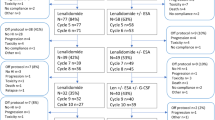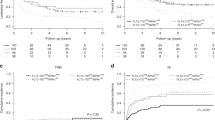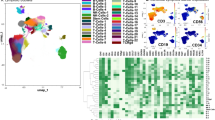Abstract
We retrospectively assessed whether normalized bone marrow WT1 levels could be used for risk stratification in a consecutive series of 584 acute myeloid leukemia (AML) patients. A cutoff value of 5065 copies at diagnosis identified two prognostic groups (overall survival (OS): 44±3 vs 36±3%, P=0.023; leukemia-free survival (LFS): 47±3 vs 36±4%, P=0.038; and cumulative incidence of relapse (CIR): 37±3 vs 47±4%, P=:0.043). Three groups were identified on the basis of WT1 levels post-induction: Group 0 (WT1 between 0 and 17.5 copies, 134 patients, OS: 59±4%, LFS:59±4% and CIR: 26±4%); Group 1 (WT1 between 17.6 and 170.5 copies, 160 patients, OS: 48±5%, LFS:41±4% and CIR: 45±4%); and Group 2 (WT1 >170.5 copies, 71 patients, OS: 23±6%, LFS: 19±7% and CIR: 68±8%) (P<0.001). Post-intensification samples distinguished three groups: patients with WT1 >100 copies (47 patients, 16%); an intermediate group of patients with WT1 between 10 and 100 copies (148 patients, 52%); and a third group with WT1 <10 copies (92 patients, 32%). Outcomes differed significantly in terms of OS (30±7%, 59±4%, 72±5%), LFS (24±7%, 46±4%, 65±5%) and relapse probability (CIR 72±7%, 45±4%, 25±5%), all P<0.001. WT1 levels in bone marrow assayed using the standardized ELN method provide relevant prognostic information in de novo AML.
This is a preview of subscription content, access via your institution
Access options
Subscribe to this journal
Receive 12 print issues and online access
$259.00 per year
only $21.58 per issue
Buy this article
- Purchase on Springer Link
- Instant access to full article PDF
Prices may be subject to local taxes which are calculated during checkout



Similar content being viewed by others
References
Buccisano F, Maurillo L, Del Principe MI, Del Poeta G, Sconocchia G, Lo-Coco F et al. Prognostic and therapeutic implications of minimal residual disease detection in acute myeloid leukemia. Blood 2012; 119: 332–341.
Cilloni D, Gottardi E, De Micheli D, Serra A, Volpe G, Messa F et al. Quantitative assessment of WT1 expression by real time quantitative PCR may be a useful tool for monitoring minimal residual disease in acute leukemia patients. Leukemia 2002; 16: 2115–2121.
Cilloni D, Gottardi E, Messa F, Fava M, Scaravaglio P, Bertini M et al. Significant correlation between the degree of WT1 expression and the International Prognostic Scoring System Score in patients with myelodysplastic syndromes. J Clin Oncol 2003; 21: 1988–1995.
Cilloni D, Messa F, Martinelli G, Gottardi E, Arruga F, Defilippi I et al. WT1 transcript amount discriminates secondary or reactive eosinophilia from idiopathic hypereosinophilic syndrome or chronic eosinophilic leukemia. Leukemia 2007; 21: 1442–1450.
Chau YY, Hastie ND . The role of Wt1 in regulating mesenchyme in cancer, development, and tissue homeostasis. Trends Genet 2012; 28: 515–524.
Hosen N, Shirakata T, Nishida S, Yanagihara M, Tsuboi A, Kawakami M et al. The Wilms' tumor gene WT1-GFP knock-in mouse reveals the dynamic regulation of WT1 expression in normal and leukemic hematopoiesis. Leukemia 2007; 21: 1783–1791.
Hohenstein P, Hastie ND . The many facets of the Wilms' tumour gene, WT1. Hum Mol Genet 2006; 15, (Spec No 2) R196–R201.
Huff V . Wilms’ tumours: about tumour suppressor genes, an oncogene and a chameleon gene. Nat Rev Cancer 2011; 11: 111–121.
Owen C, Fitzgibbon J, Paschka P . The clinical relevance of Wilms Tumour 1 (WT1) gene mutations in acute leukaemia. Hematol Oncol 2010; 28: 13–19.
Virappane P, Gale R, Hills R, Kakkas I, Summers K, Stevens J et al. Mutation of the Wilms' tumor 1 gene is a poor prognostic factor associated with chemotherapy resistance in normal karyotype acute myeloid leukemia: the United Kingdom Medical Research Council Adult Leukaemia Working Party. J Clin Oncol 2008; 26: 5429–5435.
Cilloni D, Gottardi E, Fava M, Messa F, Carturan S, Busca A et al. Usefulness of quantitative assessment of the WT1 gene transcript as a marker for minimal residual disease detection. Blood 2003; 102: 773–774, (author reply 774).
Cilloni D, Renneville A, Hermitte F, Hills RK, Daly S, Jovanovic JV et al. Real-time quantitative polymerase chain reaction detection of minimal residual disease by standardized WT1 assay to enhance risk stratification in acute myeloid leukemia: a European LeukemiaNet study. J Clin Oncol 2009; 27: 5195–5201.
Lasa A, Carricondo M, Estivill C, Bussaglia E, Gich I, Brunet S et al. WT1 monitoring in core binding factor AML: comparison with specific chimeric products. Leuk Res 2009; 33: 1643–1649.
Ommen HB, Nyvold CG, Braendstrup K, Andersen BL, Ommen IB, Hasle H et al. Relapse prediction in acute myeloid leukaemia patients in complete remission using WT1 as a molecular marker: development of a mathematical model to predict time from molecular to clinical relapse and define optimal sampling intervals. Br J Haematol 2008; 141: 782–791.
Ostergaard M, Olesen LH, Hasle H, Kjeldsen E, Hokland P . WT1 gene expression: an excellent tool for monitoring minimal residual disease in 70% of acute myeloid leukaemia patients - results from a single-centre study. Br J Haematol 2004; 125: 590–600.
Weisser M, Kern W, Rauhut S, Schoch C, Hiddemann W, Haferlach T et al. Prognostic impact of RT-PCR-based quantification of WT1 gene expression during MRD monitoring of acute myeloid leukemia. Leukemia 2005; 19: 1416–1423.
Pozzi S, Geroldi S, Tedone E, Luchetti S, Grasso R, Colombo N et al. Leukaemia relapse after allogeneic transplants for acute myeloid leukaemia: predictive role of WT1 expression. Br J Haematol 2013; 160: 503–509.
Cilloni D, Messa F, Arruga F, Defilippi I, Gottardi E, Fava M et al. Early prediction of treatment outcome in acute myeloid leukemia by measurement of WT1 transcript levels in peripheral blood samples collected after chemotherapy. Haematologica 2008; 93: 921–924.
Nomdedeu J, Bussaglia E, Villamor N, Martinez C, Esteve J, Tormo M et al. Immunophenotype of acute myeloid leukemia with NPM mutations: prognostic impact of the leukemic compartment size. Leuk Res 2010; 35: 163–168.
Mallett S, Timmer A, Sauerbrei W, Altman DG . Reporting of prognostic studies of tumour markers: a review of published articles in relation to REMARK guidelines. Br J Cancer 2009; 102: 173–180.
Grossmann V, Schnittger S, Kohlmann A, Eder C, Roller A, Dicker F et al. A novel hierarchical prognostic model of AML solely based on molecular mutations. Blood 2012; 120: 2963–2972.
Perea G, Lasa A, Aventin A, Domingo A, Villamor N, Queipo de Llano MP et al. Prognostic value of minimal residual disease (MRD) in acute myeloid leukemia (AML) with favorable cytogenetics [t(8;21) and inv(16)]. Leukemia 2006; 20: 87–94.
Ogawa H, Tamaki H . The background level of WT1 expression following alloeneic stem cell transplantation is significantly decreased. Blood 2003; 102: 774.
Ogawa H, Tamaki H, Ikegame K, Soma T, Kawakami M, Tsuboi A et al. The usefulness of monitoring WT1 gene transcripts for the prediction and management of relapse following allogeneic stem cell transplantation in acute type leukemia. Blood 2003; 101: 1698–1704.
Maurillo L, Buccisano F, Del Principe MI, Del Poeta G, Spagnoli A, Panetta P et al. Toward optimization of postremission therapy for residual disease-positive patients with acute myeloid leukemia. J Clin Oncol 2008; 26: 4944–4951.
van Dongen JJ, Lhermitte L, Bottcher S, Almeida J, van der Velden VH, Flores-Montero J et al. EuroFlow antibody panels for standardized n-dimensional flow cytometric immunophenotyping of normal, reactive and malignant leukocytes. Leukemia 2012; 26: 1908–1975.
Bergmann L, Miething C, Maurer U, Brieger J, Karakas T, Weidmann E et al. High levels of Wilms' tumor gene (wt1) mRNA in acute myeloid leukemias are associated with a worse long-term outcome. Blood 1997; 90: 1217–1225.
Barragan E, Cervera J, Bolufer P, Ballester S, Martín G, Fernández P et al. Prognostic implications of Wilms' tumor gene (WT1) expression in patients with de novo acute myeloid leukemia. Haematologica 2004; 89: 926–933.
Luesink M, Hollink IH, van der Velden VH, Knops RH, Boezeman JB, de Haas V et al. High GATA2 expression is a poor prognostic marker in pediatric acute myeloid leukemia. Blood 2012; 120: 2064–2075.
Furuhata A, Murakami M, Ito H, Gao S, Yoshida K, Sobue S et al. GATA-1 and GATA-2 binding to 3' enhancer of WT1 gene is essential for its transcription in acute leukemia and solid tumor cell lines. Leukemia 2009; 23: 1270–1277.
Gaur GC, Ramadan SM, Cicconi L, Noguera NI, Luna I, Such E et al. Analysis of mutational status, SNP rs16754, and expression levels of Wilms tumor 1 (WT1) gene in acute promyelocytic leukemia. Ann Hematol 2012; 91: 1855–1860.
Shimada A, Taki T, Koga D, Tabuchi K, Tawa A, Hanada R et al. High WT1 mRNA expression after induction chemotherapy and FLT3-ITD have prognostic impact in pediatric acute myeloid leukemia: a study of the Japanese Childhood AML Cooperative Study Group. Int J Hematol 2012; 96: 469–476.
Lapillonne H, Renneville A, Auvrignon A, Flamant C, Blaise A, Perot C et al. High WT1 expression after induction therapy predicts high risk of relapse and death in pediatric acute myeloid leukemia. J Clin Oncol 2006; 24: 1507–1515.
Garg M, Moore H, Tobal K, Liu Yin JA . Prognostic significance of quantitative analysis of WT1 gene transcripts by competitive reverse transcription polymerase chain reaction in acute leukaemia. Br J Haematol 2003; 123: 49–59.
Rossi G, Minervini MM, Carella AM, de Waure C, di Nardo F, Melillo L et al. Comparison between multiparameter flow cytometry and WT1-RNA quantification in monitoring minimal residual disease in acute myeloid leukemia without specific molecular targets. Leuk Res 2011; 36: 401–406.
Willasch AM, Gruhn B, Coliva T, Kalinova M, Schneider G, Kreyenberg H et al. Standardization of WT1 mRNA quantitation for minimal residual disease monitoring in childhood AML and implications of WT1 gene mutations: a European multicenter study. Leukemia 2009; 23: 1472–1479.
Acknowledgements
This work was supported by the following grants: Fundación Mutua Madrileña to JN 08/FMMA, Fondo de Investigaciones Sanitarias (FIS) PI 10/0173 and ISCIII PI052312, PI 080672, RD06/0020/0101 and EC07/90065, 2009-SGR-168 from Plà de Recerca de Catalunya, Marató de TV3 (100830/31/32) and a grant from Fundació Cellex, Spain. We are grateful to the CETLAM participating hospitals and to all the European Leukemia Net members (Workpackage 12, MRD).
Author Contributions
JN designed the study, analyzed the data and wrote the paper. MH analyzed the data and wrote the manuscript. MC, EB, CE, JE, MT, RD, OS, MPQLL, AG, JB, IH, JMMT, ALl, JMR, DG, AA and SB analyzed the data. JS designed the study and wrote the paper.
Author information
Authors and Affiliations
Consortia
Corresponding author
Ethics declarations
Competing interests
The authors declare no conflict of interest.
Additional information
These results were partially presented at the 54th Annual Meeting of the American Society of Hematology, 8–11 December 2012, Atlanta.
Supplementary Information accompanies this paper on the Leukemia website
Supplementary information
Rights and permissions
About this article
Cite this article
Nomdedéu, J., Hoyos, M., Carricondo, M. et al. Bone marrow WT1 levels at diagnosis, post-induction and post-intensification in adult de novo AML. Leukemia 27, 2157–2164 (2013). https://doi.org/10.1038/leu.2013.111
Received:
Revised:
Accepted:
Published:
Issue Date:
DOI: https://doi.org/10.1038/leu.2013.111
Keywords
This article is cited by
-
WT1 and TP53 as valuable diagnostic biomarkers for relapse after hematopoietic stem cell transplantation in acute myeloid leukemia
Molecular Biology Reports (2024)
-
High WT1 expression predicted induction chemotherapy failure in acute myeloid leukemia patients with non-favorable cytogenetic risk
Clinical and Experimental Medicine (2023)
-
Wilms tumor 1 gene expression in acute myeloid leukemia: prognostic significance and usefulness in minimal residual disease monitoring—a case–control study
Egyptian Journal of Medical Human Genetics (2022)
-
First-in-human study of WT1 recombinant protein vaccination in elderly patients with AML in remission: a single-center experience
Cancer Immunology, Immunotherapy (2022)
-
Application of a digital PCR method for WT1 to myeloid neoplasms in CR and deep ELN WT1 molecular response (< 10 copies)
Annals of Hematology (2020)



